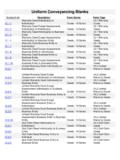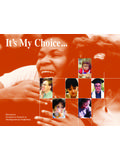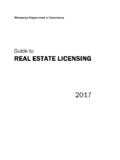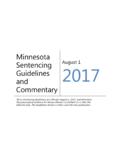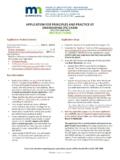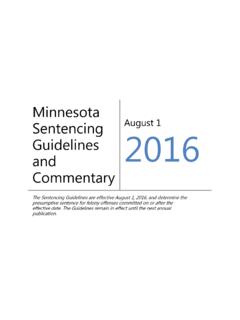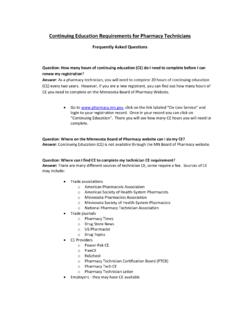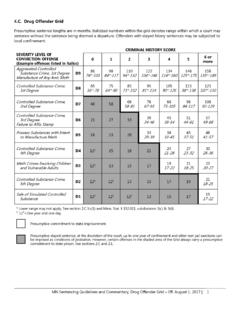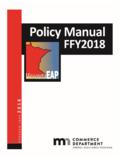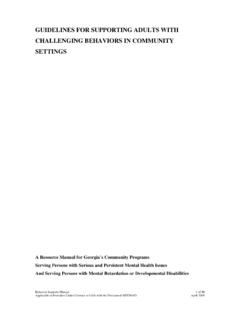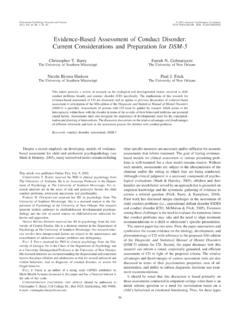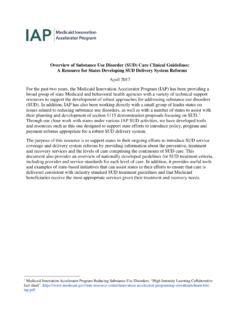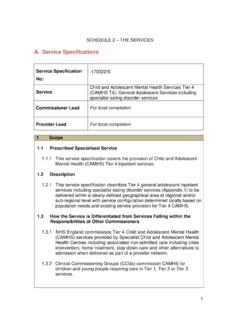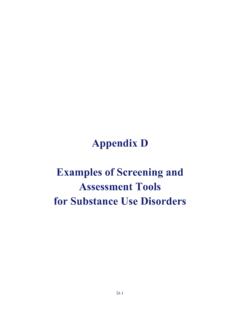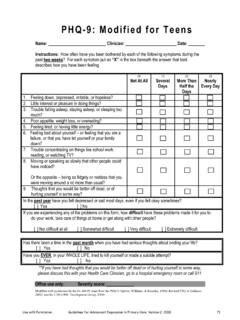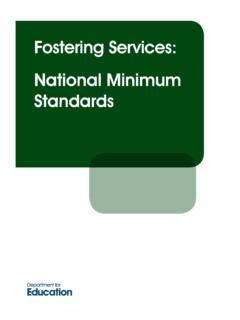Transcription of Bipolar Disorder Assessment and Treatment Protocol
1 Bipolar Disorder Assessment & Treatment 1 Concerns suggesting Bipolar Disorder ? (See Appendix) Safety Screen (see Appendix): Administer every visit Neglect/Abuse? Thoughts of hurting self or others? o If yes, does patient have a plan, means, and intent? Diagnosis: Use DSM-5 criteria (See Appendix) Consider medical conditions: temporal lobe epilepsy, hyperthyroidism, head injury, multiple sclerosis, lupus, alcohol-related neurodevelopmental Disorder , Wilson s disease Consider medications that increase mood cycling: tricyclic antidepressants, SSRIs, SNRIs, aminophylline, corticosteroids, pseudoephedrine, some antibiotics ( , clarithromycin, erythromycin, amoxicillin) Consider comorbidity/differential diagnoses.
2 ADHD, Conduct Disorder , Major Depressive Disorder , Oppositional Defiant Disorder , Psychotic Disorder , Substance Abuse, Trauma/Abuse Positive for Abuse/Neglect: Mandated Reporting as indicated Threat of harm to self or others: Consider accessing local crisis intervention services. See Appendix for link to contact information. Follow agency/ professional protocols to ensure safety Is child under age 5? Refer to Early Childhood Mental Health Specialist If child already has an Early Childhood Mental Health Specialist, referral can begin with this provider Request feedback & coordination Note: Diagnosis of Bipolar Disorder in children under age 5 is highly controversial.
3 Refer to Mental Health Specialist for Diagnostic Assessment Request feedback and coordination If the child already has a MH Specialist, referral can start with this provider. Review collaborative information If Bipolar Disorder is unlikely, exit current Protocol and identify appropriate Protocol . If Bipolar Disorder is likely, refer for psychiatric Assessment and Treatment . o Request information and coordination following referral . o See below for guidance on provider roles and responsibilities in providing concurrent Treatment .
4 Yes No Yes No Yes Bipolar Disorder Assessment & Treatment 2 Primary Care Provider Role in Mental Health Specialist Role in Concurrent psychiatric Specialist Role in Concurrent Concurrent Treatment Treatment Treatment Follow-up appointment: Frequency: Frequency: If safety concerns: 1-3 weeks Weekly or bi-weekly at start of Treatment Variable, with decreasing frequency as Review collaborative information Decreasing frequency as functioning symptoms abate Continue inquiring about mood and improves Appointment Content: behavioral symptoms Appointment Content: Review symptom presentation Review safety plan Review symptom presentation Continue inquiring about new/additional If therapy referral and no safety concerns.
5 4- Continue inquiring about new/additional concerns and safety 6 weeks concerns and safety Medications review and monitoring of side Review collaborative information Psychoeducation: refers to the education effects Continue inquiring about mood and offered to individuals with a mental health Lab testing or reviewing lab tests from behavioral symptoms condition and their families to help inform and primary care provider empower in order to optimize functioning Psychoeducation: (see definition under MH Ongoing follow-up appointments once Psychotherapy: a general term for treating specialist role) therapy has been established: mental health problems by talking with a Psychotherapy: (if not being provided by MH Frequency: mental health provider to learn about the specialist.)
6 See definition under MH specialist 13-26 weeks until symptoms abate condition, as well as moods, feelings, role) Consider comorbidity, safety, and thoughts, and behaviors symptom severity in determination of visit frequency Appointment Content: Review collaborative information Review symptom presentation Continue inquiring about new/additional concerns and safety Medications review and monitoring of side effects Lab testing or reviewing lab tests from psychiatrist Bipolar Disorder Assessment & Treatment 3 Primary References: American Academy of Child and Adolescent Psychiatry Official Action (2007) Practice Parameter for the Assessment and Treatment of Children and Adolescents With Bipolar Disorder .
7 (09)61968-7/pdf American Academy of Child and Adolescent Psychiatry Official Action (2009) Practice Parameter on the Use of Psychotropic Medication in Children and Adolescents. (09)60156-8/pdf American psychiatric Association (2013). Diagnostic and statistical manual of mental disorders (5th ed.). Washington, DC: Author. PracticeWise (2015). Evidence-Based Youth Mental Health Services Literature Database. Appendix Concerns possibly suggesting Bipolar Disorder : variable moods, short temper, changes in sleep patterns without feeling tired, risky behaviors, impulsivity and concentration problems that are variable within the same setting, rages or extensive temper tantrums, racing thoughts, hypersexuality, suicidal thoughts or behaviorsm, oversensitivity to environmental stimuli, family history of Bipolar Disorder List of Recommended Screening Tools: Resources.
8 American Academy of Child & Adolescent Psychiatry Bipolar Disorder Resource Center Safety Screen: Some questions to assess potential threat of harm to self: Children and adolescents may be asked the following diagnostic questions (Jacobsen et al., 1994). Did you ever feel so upset that you wished you were not alive or wanted to die? Did you ever do something that you knew was so dangerous that you could get hurt or killed by doing it? Did you ever hurt yourself or try to hurt yourself? Did you ever try to kill yourself?
9 *If the threat Assessment ( , Safety Screen) indicates risk of harm to self or others, educate families on the appropriate care options and safety precautions including removal of firearms from the home and securing all medications, both prescription and over-the-counter. 4 Warning Signs of Suicide: (Developed by the Department of Health and Human Services Substance Abuse and Mental Health Services Administration (SAMHSA; 2011). These signs may mean someone is at risk for suicide. The risk is greater if a behavior is new or has increased and if it seems related to a painful event, loss, or change.)
10 Threatening to hurt or kill oneself or talking about wanting to die or kill oneself Looking for ways to kill oneself by seeking access to firearms, available pills, or other means Talking or writing about death, dying, or suicide when these actions are out of the ordinary for the person Feeling hopeless Feeling rage or uncontrolled anger or seeking revenge Acting recklessly or engaging in risky activities seemingly without thinking Feeling trapped like there s no way out Increasing alcohol or drug use Withdrawing from friends, family, and society Feeling anxious, agitated.
